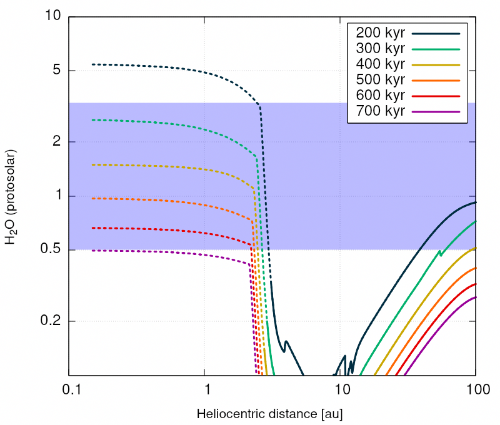- 1Aix-Marseille Université, Laboratoire d'Astrophysique de Marseille, Groupe Systèmes Planétaires, Marseille, France (artem.aguichine@lam.fr)
- 2Aix-Marseille Université, Laboratoire d'Astrophysique de Marseille, Groupe Systèmes Planétaires, Marseille, France (olivier.mousis@lam.fr)
- 3Department of Astronomy, Cornell University, Ithaca, NY 14853, USA (jlunine@astro.cornell.edu)
The formation mechanism of Jupiter is still under debate, as different scenarios of migration and gas capture reproduce Jupiter's properties [1-4]. Elemental abundances measured in Jupiter's atmosphere are key ingredients to trace the origin of various species. The Galileo probe measured the abundances of several elements (Ar, Kr, Xe, C, O, S and P), which exhibit a uniform enrichment of 2 to 6 times the protosolar abundance, except for O. Recent measurements for NH3 and H2O by the Juno mission give additional information on the abundances of these key condensables in Jupiter's gaseous envelope [5]. Here, we investigate the possible timescale and location of Jupiter's formation using measurements of molecular and elemental abundances in its enveloppe.
To do so, we use a 1D accretion disk model to compute the properties of the protosolar nebula (PSN) that includes radial transport of trace species present in the form of dust and ice particles and their vapors [6]. We focus on radial transport of volatiles crystallization via the computation of their sublimation/condensation rates, computed as they migrate through the disk, along a large set of icelines in the PSN. Initial elemental abundances are protosolar values [7], with elements of interest being C, N, O, P, S, Ar, Kr and Xe.
The figure below represents profiles of the ratio between the surface density of H2O to the surface density of the H2-He gas ∑H2O / ∑g normalized to the initial value, thus representing the enrichment to protosolar value, at different times and locations. Solid and dashed lines are used where volatiles are mostly in solid or vapor phase, respectively. The blue box corresponds to the measurement of H2O to protosolar value measured in Jupiter’s atmosphere by Juno [5]. We find that the H2O abundance in the PSN reproduces the value measured in Jupiter’s envelope within the H2O snowline at times of approx 500 kyr.

Our model reproduces Jupiter envelope’s abundance in H2O and other elements within the H2O snowline (where are volatiles are in the form of vapor), but not beyond. This suggests that Jupiter's envelope formed by rapidly accreting the gas from the protosolar nebula close to or within the H2O snowline. The derived timescale is consistent with the time required to form Jupiter's core from planetesimals, followed by a gas-accretion phase. This approach could help discriminate between the proposed scenarios for Jupiter's formation, but also give some clues on the composition and dynamics of the protosolar nebula.
[1] Gautier, D., Hersant, F., Mousis, O., et al. 2001, ApJL, 550, L227.
[2] Mousis, O., Ronnet, T., and Lunine, J. I. 2019, ApJ, 875, 9.
[3] Öberg, K. I. and Wordsworth, R. 2019, AJ, 158, 194.
[4] Miguel, Y., Cridland, A., Ormel, C. W., et al. 2020, MNRAS, 491, 1998.
[5] Li, C., Ingersoll, A., Bolton, S., et al. 2020, Nature Astronomy, 4, 609.
[6] Aguichine, A., Mousis, O., Devouard, B., and Ronnet, T. 2020, ApJ, 901, 97.
[7] Lodders, K., Palme, H., & Gail, H.-P. 2009, Landolt Börnstein, 4B, 712
How to cite: Aguichine, A., Mousis, O., and Lunine, J.: Constraints on the timescale and location of Jupiter's formation from Juno measurements, Europlanet Science Congress 2021, online, 13–24 Sep 2021, EPSC2021-148, https://doi.org/10.5194/epsc2021-148, 2021.

